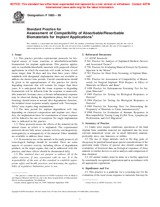We need your consent to use the individual data so that you can see information about your interests, among other things. Click "OK" to give your consent.
ASTM F1983-99
Standard Practice for Assessment of Compatibiltiy of Absorbable/Resorbable Biomaterials for Implant Applications
STANDARD published on 10.6.1999
The information about the standard:
Designation standards: ASTM F1983-99
Note: WITHDRAWN
Publication date standards: 10.6.1999
SKU: NS-52339
The number of pages: 5
Approximate weight : 15 g (0.03 lbs)
Country: American technical standard
Category: Technical standards ASTM
Annotation of standard text ASTM F1983-99 :
Keywords:
absorbables, biocompatibility, degradables, implantation, resorbables, ICS Number Code 11.040.40 (Implants for surgery, prothetics and orthotics)
Additional information
| 1. Scope | ||||||||||||||||||
|
1.1 This practice provides experimental protocols for biological assays of tissue reactions to absorbable/resorbable biomaterials for implant applications. This practice applies only to resorbable/absorbable materials with projected clinical applications in which the materials will reside in bone or soft tissue longer than 30 days and less than three years. Other standards with designated implantation times are available to address the shorter time periods. Careful consideration should be given to the appropriateness of this practice for slowly degrading materials that will remain for longer than three years. It is anticipated that the tissue response to degrading biomaterials will be different from the response to nonresorbable materials. In many cases, a chronic inflammatory response may be observed during the degradation phase, but the local histology should return to normal after degradation; therefore, the minimal tissue response usually equated with "biocompatibility" may require long implantations. 1. 2 The time period for implant degradation will vary depending on chemical composition and implant size; therefore, the implantation times for examination of tissue response will be linked to the rate of resorption. No single implantation time is indicated in this practice. 1.3 These protocols assess the effects of the material on the animal tissue in which it is implanted. The experimental protocols do not fully assess systemic toxicity, carcinogenicity, teratogenicity, or mutagenicity of the material. Other standards are available to address these issues. 1.4 To maximize use of the animals in the study protocol, all toxicological findings should be recorded. There are some aspects of systemic toxicity, including effects of degradation products on the target organs, that can be addressed with this practice, and these effects should be documented fully. 1.5 This standard does not purport to address all of the safety concerns, if any, associated with its use. It is the responsibility of the user of this standard to establish appropriate safety and health practices and determine the applicability of regulatory limitations prior to use. |
||||||||||||||||||
| 2. Referenced Documents | ||||||||||||||||||
|
We recommend:
Updating of laws
Do you want to be sure about the validity of used regulations?
We offer you a solution so that you could use valid and updated legislative regulations.
Would you like to get more information? Look at this page.




 Cookies
Cookies
